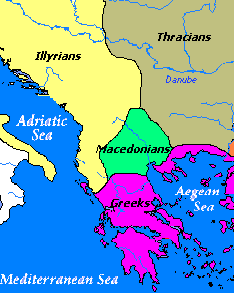| Group | Single |
| Geography | Illyrians used to inhabit a vast region from modern Hungary to Greece. Illyrian traces are noticed even in southern Poland, Illyrian elements exist in Baltic and Slavic languages. |
| History | About 1300 B.C. this people of Indo-European stock settled on the northern
and eastern coasts of the Adriatic Sea. Included among its members were
various tribes of Dalmatians and the Pannonians. Those of Illyrians who
crossed the Adriatic and settled in Italy spoke the Messapic language.
The Greeks established cities on the Adriatic coast of Illyria in the 7th
and 6th centuries B.C., and in the 4th and 3rd, Macedonian kings conquered
parts of the land. The last Illyrian kingdom was established in the 3rd
century B.C. with the capital in Scodra (now Shkoder, Albania). After Dalmatia
seceded from the Illyrian kingdom the Romans conquered Scodra and there
established, in 168 B.C., a colony they named Illyricum. Gradually Dalmatia
was conquered (78-77 B.C.); then, by 35-34 B.C. the southern areas of the
former kingdom of Illyria were added and, in 9 B.C., Pannonia in the north.
After the fall of the Western Roman Empire in 476, the region of ancient
Illyria became part of the Byzantine Empire.
In the next two centuries Slavic peoples gradually drifted in to settle on Illyrian lands, and as early as the 6th century, North Illyrians, who lived in Pannonia and modern Croatia and Slovenia, were completely assimilated by them. |
| Phonetics | The set of Indo-European vowels *a, *e, *o became a, e in Illyrian. Most of diphthongs were well preserved, as well as the sonant sounds. Indo-European voiced aspirates coincided with simple voiced consonants. It is still unknown whether Illyrian was a satem or a centum language. |
| Morphology | Morphology of Illyrian is scarcely known. Ancient noun stems *a, *o and consonant stems are definitely present. Nominal formants used for adjectives and participles include -nd-, -nt-, -r-, -st- and others. |
| Lexicon | The vocabulary includes mainly personal names and place names, though a number Indo-European roots can be noticed. |
| Writing | No writing |
| Close Contacts | Messapic was in fact a branch of Illyrian in Italy; other close tongues were Venetic, Italic, Celtic, long contacts with Thracian also led to significant mutual influence. |
| Picture |  |
| More info |